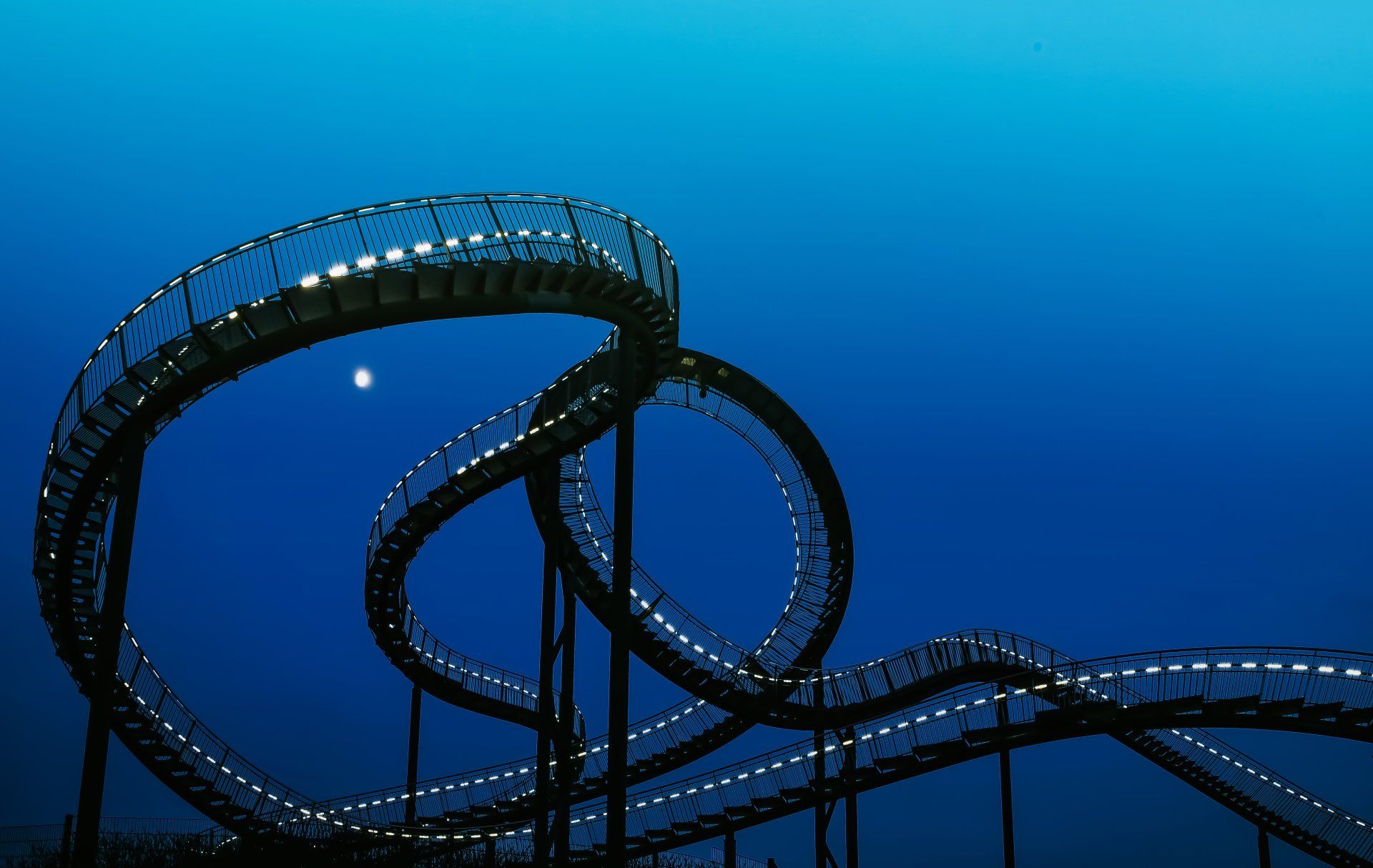IMPOSANTE INDUSTRIEKULISSE "Landmarken der Industriekultur"
Der Künstler Otto Piene entwarf für diesen am Rhein vor einer imposanten Industriekulisse gelegenen Standort „Das Geleucht“ als Sinnbild für „Kohle, die Wärme und Energie durch Feuer schafft und die Grubenarbeit, mit ihren besonderen Bedingungen und Gefahren. Als erster Zechenstandort am linken Niederrhein spiegeln sich an dieser Stelle ganz besonders die Geschichte und die Werte des Bergbaus wider. Es ist die größte Grubenlampe der Welt.
Faszinierend ist der Anblick bei Nacht, wenn die Grubenlampe und ihr riesiges „Ausleuchtungsfeld“ die Szenerie in rubinrotes Licht tauchen. Wie ein glühender Eisenstrom, der damit eine weitere gedankliche Verbindung zur Montanindustrie schafft – denn nicht nur die Arbeit „unter Tage“ prägte die Region nachhaltig, auch die Eisenhütten und Stahlwerke.
“Das Geleucht" (The miner’s lamp) on the Rheinpreußen spoil tip in Moers
Like a glowing red buoy, “Das Geleucht” on the summit of the Rheinpreußen spoil tip in Moers stretches into the night sky. The colossal miner’s lamp is one of the most striking works of art among the landmarks in the Ruhr Valley. While the industrial culture sculpture, which can be walked on, is visible during the day, an impressive interplay of light and shadow unfolds, particularly in the darkness, that can be seen all the way down to the nearby Rhine.
A green spoil tip for walking in the Ruhr Valley
Along with the miner’s lamp, the spoil tip is over 120 metres high and is thus the largest mining work of art in the world. You can also enjoy a stunning panoramic view across the Ruhr Valley from the viewing platform.
Miner’s lamp to the rescue on the Rheinpreußen Colliery
Landschaftspark Duisburg-Nord – beeindruckende Industriekultur
Ursprünglich ein Eisenhüttenwerk, zählt der Landschaftspark Duisburg-Nord heute zu den bedeutendsten Industriedenkmälern Europas.Der gesamte Park erstreckt sich über eine Fläche von etwa 180 Hektar.
Der Landschaftspark Duisburg-Nord ist das herausragende Beispiel für einen industriell geprägten Park. Im Zentrum der 180 Hektar großen Grünfläche steht das stillgelegte Thyssen-Hochofenwerk Duisburg-Meiderich. Von 1901 bis 1985 wurde hier Roheisen für die Stahlindustrie produziert.
Heute können Besucher das stillgelegte Hüttenwerk als lebendiges Industriedenkmal erleben. Mit seinen drei in der Reihe stehenden Hochöfen, den Bunkeranlagen, Schrägaufzügen und Gießhallen vermittelt der Landschaftspark Duisburg-Nord das traditionelle Bild einer Hochofenanlage der Jahrhundertwende.
Landscape Park Duisburg Nord
At the Landscape Park Duisburg Nord extending over an area of about 180 hectares, nature, industrial heritage and a fascinating light installation combine to create a park landscape unlike any other in the world. At the centre stands a disused ironworks whose old industrial facilities have today been put to a wide variety of uses. The huge buildings of the former ironworks have been equipped to cater for cultural and corporate functions; in an old gasometer Europe's biggest man-made diving centre has been created; alpine climbing gardens have been created in ore storage bunkers; in a former casting house a high ropes course has been set up; and an extinguished blast furnace has been modified to now function as a viewing tower.
The Landscape Park Duisburg Nord an outstanding example of a new type of park shaped by industry. At the centre of an area of about 180 hectares, stands the decommissioned Thyssen ironworks in Duisburg-Meiderich. From 1901 to 1985 the works produced pig iron - as a rule as a primary product for further processing in Thyssen's steel works.
Today, visitors can explore the old ironworks as a “living” industrial monument. With its three blast furnaces standing in a row, bunkers, inclined lifts and casthouses, Meiderich ironworks conveys the traditional image of a turn-of-the-century blast furnace plant.

The Tiger and Turtle – Magic Mountain
is a kind of viewing platform in the landscape that is also part of the landscape.
One of Duisburg's weirdest landmarks, a rollercoaster-like sculpture you can walk on!
Particularly impressive is the landmark in the dark. Then 880 LEDs draw the sweeping turns of the steel sculpture into the night sky.
Tiger and Turtle – Magic Mountain ist eine begehbare Achterbahn mit Looping. Die Großskulptur ist ein Kunstwerk von Heike Mutter und Ulrich Genth, das im Rahmen der Kulturhauptstadt Ruhr.2010 entwickelt wurde. Vor allem zur Abendstunde ist die Skupltur Tiger and Turtle eine Reise wert. Dann nämlich erstrahlt sie mit ihrer geschwungenen Form in prachtvollem Licht.






